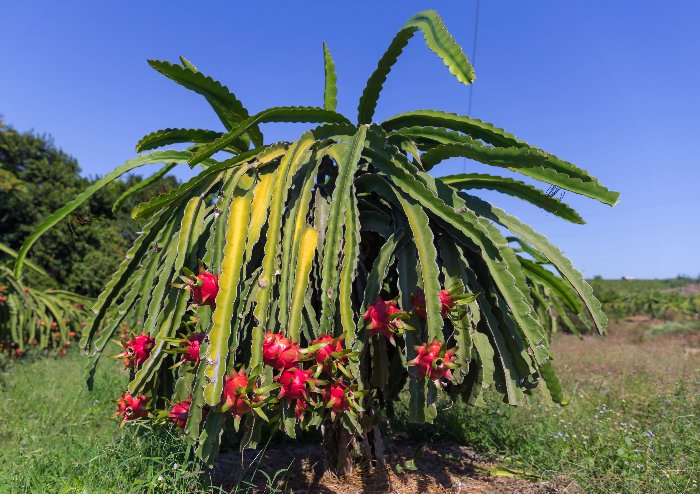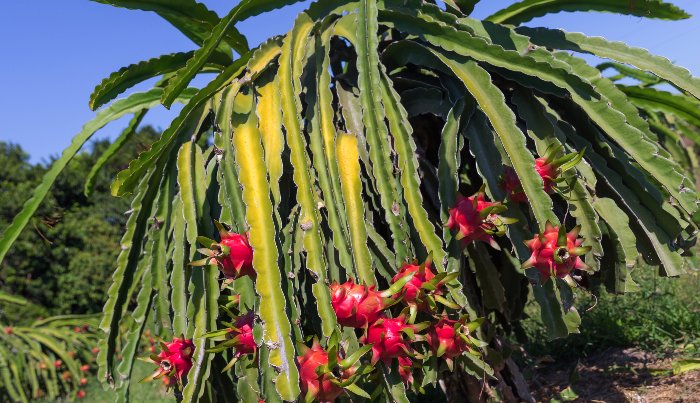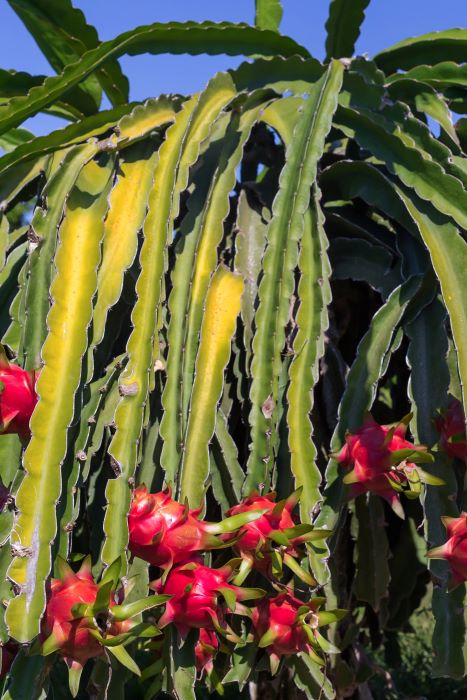With their vibrant green stems and exotic fruits, dragon fruit plants can be an amazing addition to any home garden. However, witnessing your dragon fruit plant turning yellow can be disheartening. Yellowing of the plant’s stem can indicate a variety of underlying issues.

Related: How To Grow Dragon Fruit: Planting, Caring And Harvesting
Table of Contents
Why is My Dragon Fruit Plant Turning Yellow?
The most likely reasons your dragon fruit plant is turning yellow are disease, over-watering or poor drainage, too much sun, nutrient issues, and certain pests.
Read on to explore the common reasons why your dragon fruit plant may be turning yellow and learn practical tips on how to fix the problem!
1. Diseases
Even the most hardy plant can be affected by diseases, including your dragon fruit plant. From insidious fungi to destructive bacteria, diseases can pose a serious risk to the health and productivity of your dragon fruit plant.
One of the most common diseases that affect dragon fruit plants is Dragon fruit stem rot.
Dragon Fruit Stem Rot
The most likely reason your dragon fruit plant is turning yellow is due to Dragon fruit stem rot.
Dragon fruit stem rot, also known as stem rot disease, is a common issue that dragon fruit growers may encounter.
The disease can be caused by over-fertilizing and over-watering your plants. Additionally, high humidity and rain after a period of warm weather can cause the stem of your plant to rot.
Stem rot occurs when the plant’s stems become infected by various pathogens, leading to decay, discoloration, and, ultimately, the plant’s decline if left untreated. Several different fungi and bacteria can cause stem rot.
Depending on whether the stem rot is caused by a fungus or bacteria, dragon fruit stem rot will present with the yellowing and rotting of the blades and stem. Reddish-brown lesions will appear on the blades if your plant plays host to a fungus.
How to Fix It: If your plant has fruit stem rot, you should remove the affected stems. Next, you need to make sure you’re not over-watering your dragon fruit plant and that the soil drains correctly. You can also try using a copper-based fungicide like this one which can be effective on fungus disease if caught early enough. Ensuring the plant is in full sun and has good airflow will also help prevent disease.
2. Over-watering or Drainage Issues
Just as too little water can harm your plant, too much water can have detrimental effects. Over-watering your dragon fruit plant can cause your plant to turn yellow because it creates the perfect conditions for certain fungi and bacteria to infect your plant.
If you’re watering your dragon fruit plant correctly, and it is still turning yellow, your soil may have a drainage issue. That means that when you water your plant, the water does not drain into the soil correctly. Instead, the water sits, making the soil and your plant’s roots damp.
Watering your dragon fruit plant too much or having poor draining soil means that your plant’s roots may become waterlogged. This, in turn, creates the perfect environment for root and stem rot to flourish. Root rot causes your dragon fruit plant’s roots to turn black and mushy, meaning your plant will not get the correct nutrients and water it needs to thrive.
How to Fix it: Your mature dragon fruit plant should be watered about once every two weeks. But there is a period during winter and spring when your plant needs to be dry to help with the bloom. Generally, you should never water your plant if the soil feels wet. It’s ok if it feels slightly damp.
If your issue is caused by poor draining soil, you can add organic matter like manure and compost. Both compost and manure help create good soil drainage.
3. Too Much Sun

Despite being a plant suited for tropical environments and needing full sun of at least 6-8 hours a day, your dragon fruit plant can get too much sun. If your dragon fruit plant has experienced long periods of sun exposure or extreme heat, it may begin to turn yellow.
The yellowing of your dragon fruit plant is a condition called sunscald and is actually a disease rather than sunburn. The disease is triggered by prolonged exposure to heat. Sunscald begins with brown spots that first appear on the pads of your plant. The site of the spot will eventually crack and spread, causing the plant to rot.
As a member of the Cactus family, dragon fruit plants thrive in sub-tropical conditions with ideal temps around 65-77 °F (18-25 °C) and will cope fine up to 100 °F (37 °C).
But your dragon fruit plant can still suffer from sunburn – especially when temperatures are hitting 100 °F (37 °C) and over. Sunburn looks different from sunscald. If your dragon fruit plant has been burnt by the sun, it will look yellow or white and will not spread.
How to Fix It: Cover your plants with shade cloth during the hottest part of the day to ensure your dragon fruit does not get too much sun. If your plant is suffering from sunscald, you should remove the affected parts after ensuring you can provide more shade.
4. Nutrient Issues
The nutrient balance in the soil plays a crucial role in the overall health and growth of your dragon fruit plant. An excess and a deficiency of nutrients can harm the plant’s development and productivity.
If your dragon fruit plant gets too many or too few nutrients from the soil, you will notice that your plant will begin to turn yellow for different reasons.
If your dragon fruit plant is getting too many nutrients from being fertilized too frequently; the root system will get burnt. This means that the plant will not be able to get the correct amount of water or nutrients from the soil. The dragon fruit plant will begin to turn yellow, begin to rot, and eventually die.
If your dragon fruit plant is not getting enough nutrients from the soil, its growth will appear stunted. This is quickly followed by yellow discoloration of the stems.
How to Fix it: Your dragon fruit plant needs to be fertilized every few months during its growing period, starting when the plant is around 3 months. Before this, your dragon fruit plant is establishing itself.
After 3 months you can begin fertilizing with a balanced organic fertilizer.
My preferred method for fertilizing dragon fruit plants is by using aged manure and compost applied every few months. The addition of bone meal and fish emulsion applied alternatively will also give your plants a boost and nourish the soil. I also use this organic fruit and nut fertilizer which is specially designed for fruiting plants and trees.
While researching this article, I also found recommendations for fertilizer with NPK (nitrogen, phosphorus, and potassium) added in equal measure, or a 1:1 ratio. For example, NPK of 16-16-16, 13-13-13, 10-10-10, 6-6-6 and so on. Then once flowering begins, you could switch to an 8-4-12 to encourage blooms and fruit set.
If your dragon fruit plant has been over-fertilized, the first thing to do is stop adding fertilizer to your plants immediately. Next, you can flush the soil with water to remove any excess fertilizer.
I find watering early in the morning works well as it gives the soil a chance to dry out, avoiding further damage to the root system.
You will also want to keep your plant cool, as the heat increases your dragon fruit plant’s nutrient uptake. Apply a layer of mulch around your dragon fruit plant to help keep the soil moist and its roots cool.

5. Pests
We’re not the only ones who think dragon fruits are delicious, and several garden pests love too much of your plants. Many pests that like to attack dragon fruit plants will cause your plant to turn yellow.
Sap-sucking pests, such as mealybugs, spider mites, aphids, and scale insects, can have a detrimental effect. Mealybugs can attack the fruit and stem of your dragon fruit plant. They use stingers to pierce your plant and feed on the nutrients found in your plant’s sap. The point of entry will turn brown, and the fruit of your plant will turn yellow.
How to Fix it: Luckily, sap-sucking pests are some of the easiest to dislodge, if not eradicate. If you spot any of the little critters above on your dragon fruit plant, the first thing to do is give your plant a good spray with the garden hose.
After you have dislodged the tiny invaders, you will need to apply a repellent. I have found that the best way to control an aphid infestation is by applying dishwashing soap and water to the infested plant or insecticidal soap. This mixture also works on a mealybug infestation. For spider mites and scale, you can use neem oil.
Some Favorite Gardening Products
Further reading:
